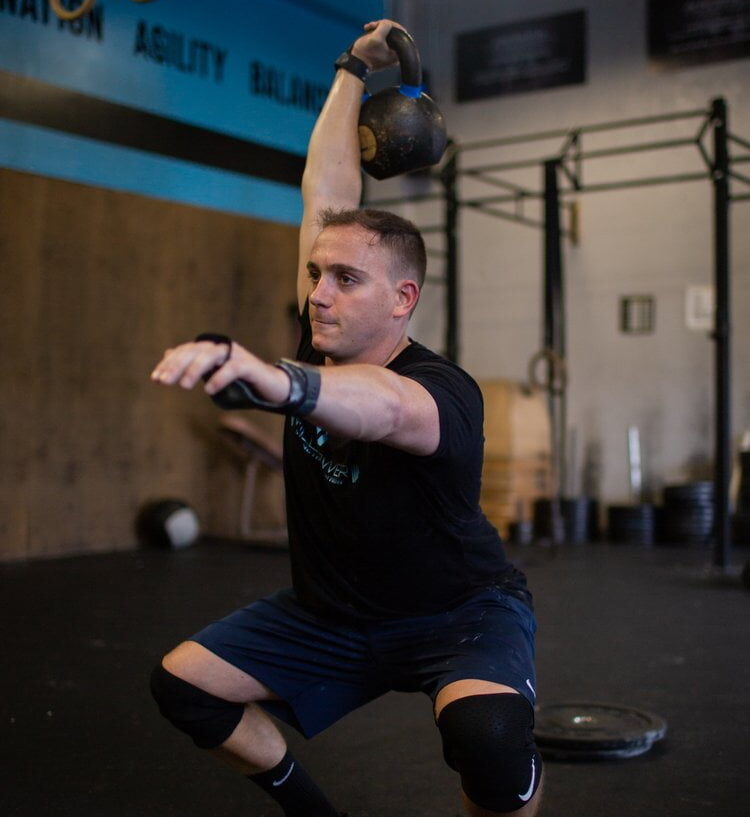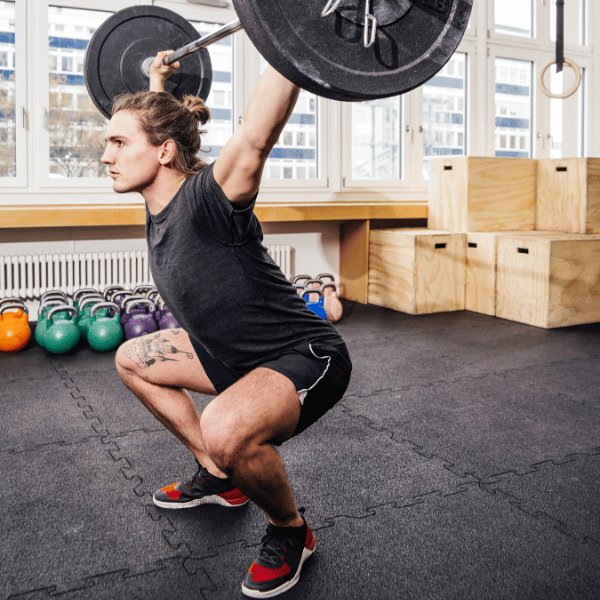The 10 Best CrossFit Stretches For Better Flexibility
Stretching is often overlooked in CrossFit training, but it’s one of the most powerful tools for elevating performance.
I know this because I have seen it firsthand with my 1:1 Pain-Free Performance Program clients.
With consistent mobility training based on what you need as an athlete, you move, feel, and perform better.
Think about the moments during a workout when you struggle to hit the depth in a squat or feel tightness in your shoulders when going for an overhead press.
That’s where individualized CrossFit stretches can come into play.
Incorporating regular stretching into your training can unlock a new level of mobility and flexibility, making those deep squats, Olympic lifts, and even gymnastic movements feel smoother and more efficient.
When your joints can glide through their full range of motion, you’ll be able to perform movements with optimal form—setting you up to lift heavier, move faster, and stay injury-free.
If you’ve been skipping the stretch, it’s time to reconsider.
But there definitely is a right way to go about your stretching routine.
For example, you may not want to utilize long duration stretching prior to your workouts if performance is your goal (1).
There is also a big difference between flexibility and mobility exercises. Both are vital to your success as a CrossFit athlete. (2)
In this article, I’ll outline my top ten stretches for CrossFit athletes and provide you with everything you need to know to incorporate them into your training routine and maximize their effectiveness.
Stick with me, and I’ll show you how a simple stretch routine can make a major difference in your CrossFit game.
What Are The Best CrossFit Stretches?
I have been a Physical Therapist and CrossFit coach for fourteen years.
Through targeted training, I have helped CrossFit athletes of all ability levels eliminate pain, mobilize tight muscles, and train with proper form.
If you are looking for the best stretches to complement your CrossFit workout, look no further than these ten stretches.
They include both static stretches for enhanced flexibility and dynamic stretches for mobility and core temperature elevation.
Combining both is a great way to enhance our mobility and recovery process so that you are ready for anything your training throws at you.
Give them a shot and check out the demo videos for proper technique.
Stretch #1: Couch Stretch
The Couch Stretch is a powerful hip flexor stretch that targets the quads and helps improve your lower body flexibility for squatting.
To perform, place one knee on the ground and the other foot in front in a lunge position, with your back foot elevated on a bench or wall.
Lean your hips forward to feel a deep stretch in the hip flexors and quads.
This stretch is ideal for opening up tight hips, making it easier to achieve better depth in squats.
Stretch #2: Pigeon Pose
Pigeon Pose is essential for loosening tight hips and improving mobility, especially after heavy squats or lunges.
The pigeon stretch particularly targets the piriformis muscle and glute muscles.
Start in a high plank, then bring one knee forward and out in front of you, laying the shin flat on the ground.
Extend the other leg behind you and lower your hips towards the floor.
This stretch targets the hips, glutes, and lower back, enhancing flexibility and relieving tension.
Stretch #3: Active Bar Hang
The Active Bar Hang is great for stretching and decompressing the shoulders, improving overhead position, and building grip strength.
Hang from a pull-up bar with an active shoulder position—engage your lats and slightly retract your scapulae.
This stretch helps improve shoulder mobility for overhead movements, making exercises like pull-ups and presses feel smoother.
Stretch #4: Thoracic Spine Extension Over Foam Roller
This stretch focuses on improving thoracic spine mobility through dynamic movement, which is crucial for the overhead squat, overhead presses and posture.
Lie on your back with a foam roller placed under your upper back.
With your hands behind your head, gently extend your upper back over the roller.
This helps open up the thoracic spine, allowing for better overhead movement and reducing stiffness in the upper back.
Stretch #5: Supine Hamstring Stretch
The Supine Hamstring Stretch targets your posterior chain and is perfect for increasing hamstring flexibility, essential for deadlifts and kettlebell swings.
Lie on your back with one leg extended and the other lifted straight up.
Grab the back of your lifted leg and gently pull it towards you.
Keeping the thigh where it is, extend the knee as far as ou can until you feel the stretch.
Then, flex the knee to rest and repeat.
This stretch helps improve your hamstring mobility, reducing strain on the lower back during pulling movements.
Stretch #6: Cat-Cow
The Cat-Cow stretch is a simple yet effective way to improve spinal mobility and reduce tension.
Start on all fours, arching your back up (Cat) and then lowering your belly while lifting your head and tailbone (Cow).
This movement stretches the spine and improves flexibility, which is key for maintaining a healthy back during CrossFit movements.
Stretch #7: Saddle Pose Stretch
Saddle Pose targets the quads and lower back, providing a deep stretch through the hips and front of the thighs.
Sit on your heels with your legs bent beneath you, then slowly lean back onto your hands or elbows or even all the way to the floor.
This stretch is excellent for increasing flexibility in the quads and improving overall hip mobility.
Stretch #8: Standing Calf Stretch
This stretch focuses on the gastrocnemius muscle (calf) and is great for improving ankle mobility.
Stand facing a squat rack or wall, place one foot against it with the heel on the ground, and lean forward.
You’ll feel a stretch through your calf, which is crucial for movements like double-unders and running.
Stretch #9: 1/2 Kneeling Banded Shoulder Distraction
This stretch improves shoulder mobility by using banded tension to create space in the joint.
Attach a band to a rig, loop it around your wrist, and kneel down with the opposite leg forward.
Let the band gently pull your arm backward while keeping your shoulder relaxed.
This stretch is ideal for preparing your shoulders for overhead lifts.
Stretch #10: Hip 90/90 Rotations
Hip 90/90 Rotations are fantastic for improving hip rotation and mobility.
Sit on the floor with one leg in front of you at a 90-degree angle and the other leg behind you at 90 degrees.
Slowly rotate your hips from side to side, transitioning between internal and external rotation.
This stretch enhances hip mobility, which is vital for squatting and lunging movements.
Mobility vs. Flexibility
Stretching is a crucial component in enhancing both mobility and flexibility.
Mobility refers to how well a joint moves through its range of motion, while flexibility is about how your muscles lengthen and contract. (2)
By incorporating stretching into your routine, you can work on both.
Improved mobility allows you to squat deeper, snatch better, and move more efficiently, while flexibility helps prevent stiffness and makes movements feel smoother.
When you stretch consistently, you’ll notice improvements in how easily your body handles challenging WODs.
Stretching and Injury Prevention
While stretching won’t directly prevent injuries, it does play an important role in reducing your risk by improving how you move. (3)
When your mobility is restricted, your body has to compensate, often placing strain on other joints or muscles.
For example, tight hips might force your knees or lower back to take on extra load during a squat.
This can increase the risk of injury over time.
By stretching regularly and moving better, you’re better able to disperse forces during complex movements, which indirectly reduces the likelihood of injuries to common areas like the shoulders, knees, and hips.
Enhancing Recovery Between Workouts
Stretching also aids in recovery by helping your body shift from a sympathetic (fight-or-flight) state into a parasympathetic (rest-and-digest) state. (4)
After a tough WOD or heavy strength training session, your body is in overdrive.
Engaging in a post-workout stretching routine calms your nervous system, reduces muscle tension, and helps promote blood flow to fatigued muscles.
This can accelerate recovery, allowing you to get back to training with less soreness and more energy.
How To Incorporate These Stretches
Integrating these stretches at the right times during training is important to getting the most out of them.
You can either incorporate them during your workout or use them as part of your cooldown routine.
Intra Workout:
Pairing stretches with your main movements for the day can enhance mobility and prepare your body for the specific demands of the workout.
For example, using the Couch Stretch before squats can open up your hips and improve your range of motion, allowing for deeper, more controlled squats.
By integrating stretching during your training, you’ll target tight areas that may limit your performance, making your movements more efficient.
Post Workout:
Stretches are also ideal for cooling down after a tough CrossFit session.
After your workout, stretching helps relax your muscles, bringing your nervous system into a parasympathetic state (rest and recovery).
Static stretching will aid in recovery, reduce muscle tension, and promote blood flow to fatigued areas, helping you recover faster and prepare for your next session.
Final Thoughts on The Top 10 Stretches For CrossFit Athletes
Incorporating these 10 essential stretches into your CrossFit stretching routine will not only boost your flexibility but also help you move and feel better in the gym.
When done correctly, stretching can be an important part of training and staying healthy.
They routinely work for both myself and my clients in my 1:1 Pain-Free Performance and Bulletproof Training Programs.
If you want to up your stretching game then start with these today and stay consistent so you can feel the difference they make in your movement for yourself.
Ready to take your training to the next level? Try out these stretches and see how they enhance your workouts.
References:
1. Opplert, J., & Babault, N. (2018). Acute Effects of Dynamic Stretching on Muscle Flexibility and Performance: An Analysis of the Current Literature. Sports Medicine, 48(2), 299–325. https://doi.org/10.1007/s40279-017-0797-9
2. International Sports Sciences Association. (2021, August 23). Mobility vs flexibility – What’s the difference? ISSA. https://www.issaonline.com/blog/post/mobility-vs-flexibility-whats-the-difference
3. Small, K., Mc Naughton, L., & Matthews, M. (2008). A systematic review into the efficacy of static stretching as part of a warm-up for the prevention of exercise-related injury. Research in sports medicine (Print), 16(3), 213–231. https://doi.org/10.1080/15438620802310784
4. Eda, N., & Ito, H. (2020). Beneficial Effects of Yoga Stretching on Salivary Stress Hormones and Parasympathetic Nerve Activity. Journal of Sports Science & Medicine, 19(4), 695–702. https://www.ncbi.nlm.nih.gov/pmc/articles/PMC7675619/







